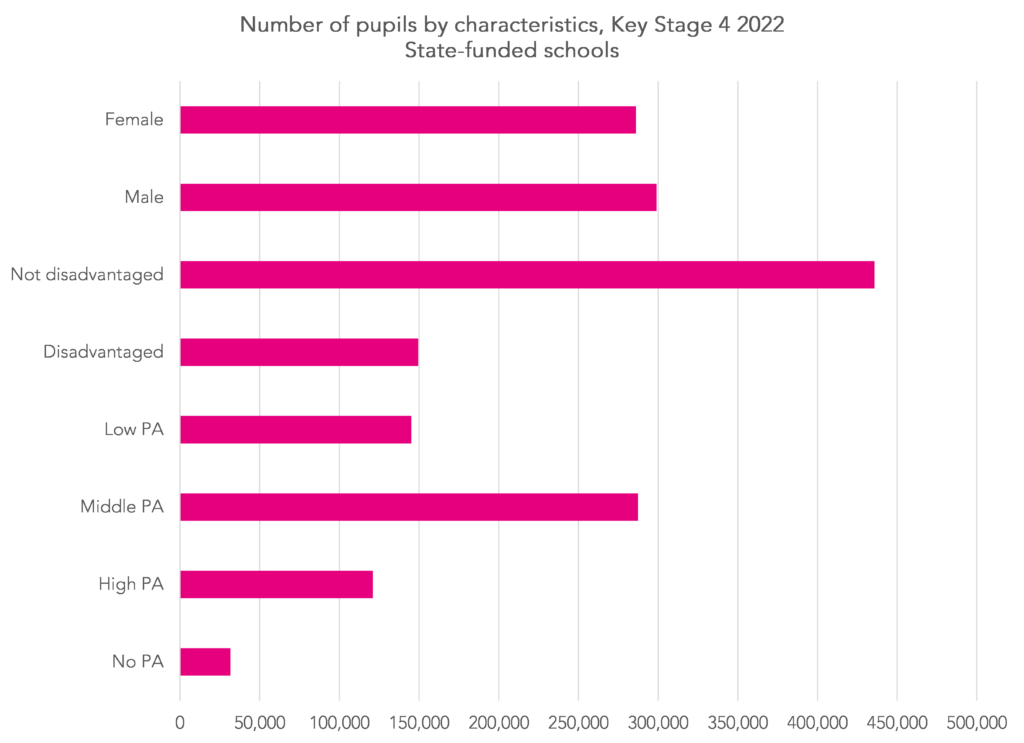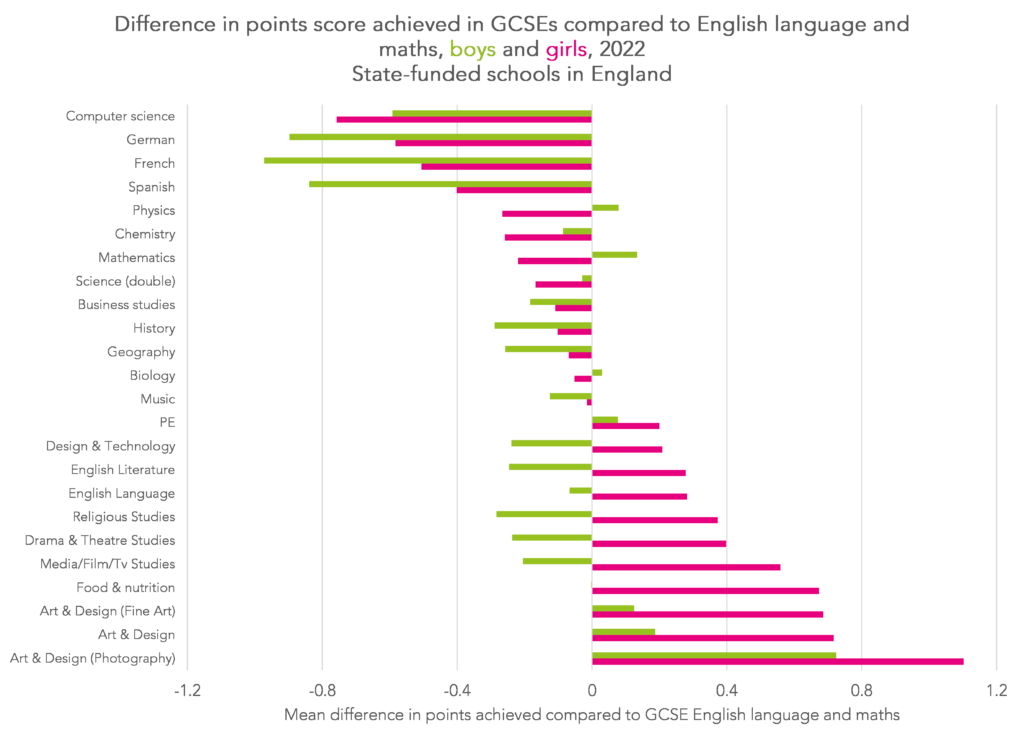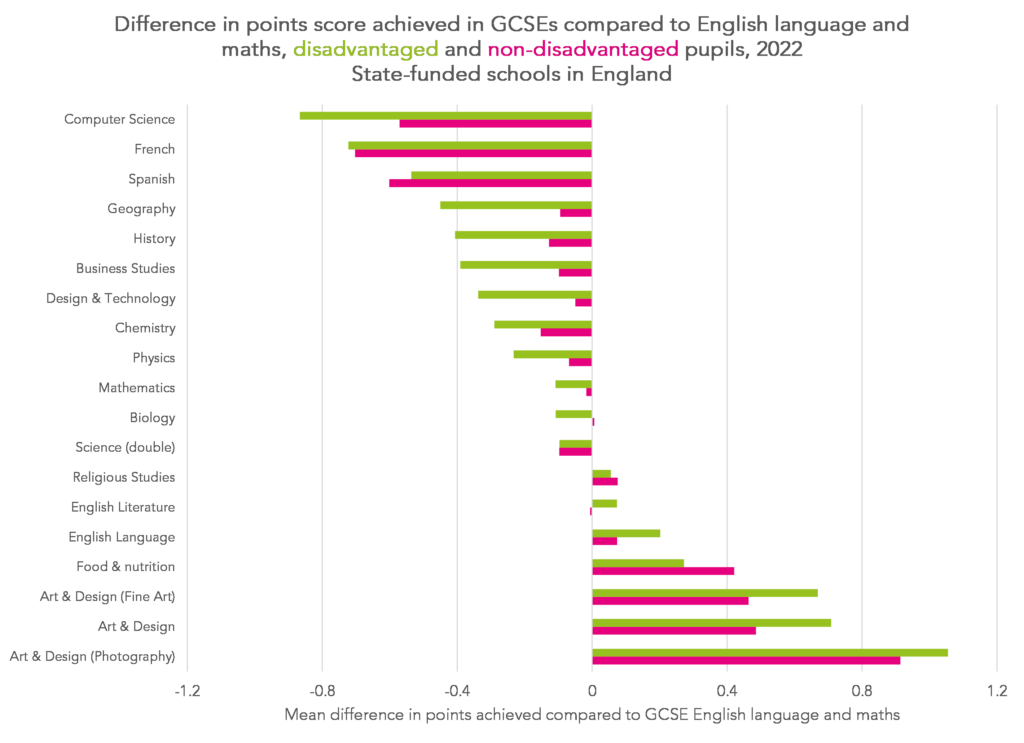In our previous post, we examined the severity of grading in GCSEs and other popular equivalent qualifications relative to GCSE English and maths in 2022.
In this post, we examine whether this varies for different groups of pupils based on three characteristics:
- Gender
- Disadvantage
- Prior attainment
Data
As in our previous post, we use amended Key Stage 4 data for 2022 for pupils on roll in state-funded mainstream and special schools.
This contains results in all approved qualifications entered by pupils in GCSEs and equivalent qualifications. We restrict ourselves to just those qualifications that are in scope of Key Stage 4 Performance Tables.
For each pupil, we calculate their average grade in English language and maths. These are the two subjects we would expect the vast majority of pupils to enter.
For each subject, we compare the grade achieved by each pupil to their average score in English and maths. Non-GCSE qualifications are allocated scores equivalent to GCSE grades for the purposes of Performance Tables (XLSX) which we use in place of grades.
The chart below shows the number of pupils by characteristic. There were slightly more boys than girls, just over 25% of pupils were disadvantaged, and almost half of pupils were in the middle prior attainment (PA) group[1]. There were slightly more pupils in the low PA group than the high PA group and 5% of pupils had no PA data.
Gender
Firstly, let’s compare severity of grading relative to English and maths for boys and girls.
On the chart below we show all subjects with at least 10,000 entrants for both boys and girls.
This reveals a number of interesting differences.
Firstly, boys tended to achieve lower grades relative to their English and maths average in drama, media studies, religious studies, design and technology and English literature. On the other hand, girls tended to achieve higher grades.
Boys’ relative performance was higher than that of girls in maths, science and computer science.
However, MFL and computer science appear to be graded more severely for both boys and girls.
Disadvantage
There are fewer subjects entered by at least 10,000 pupils. These are shown in the chart below.
Compared to other pupils, relative performance tends to be stronger among disadvantaged pupils in art and design and English language.
By contrast, relative performance among disadvantaged pupils tends to be lower in sciences, humanities (geography and history), design and technology, and business studies.
Prior attainment
Because of variations in subject entry patterns with respect to prior attainment, we show a chart for each prior attainment band.
Again, we show subjects with at least 10,000 entrants.
We start with pupils in the low prior attainment band.
This shows strong relative performance in art and design and, to a lesser extent, food and nutrition. This would indicate a group of pupils who may have tended to struggle with English and maths during a school finding a subject at which they could succeed.
Among those with average prior attainment, those who enter art and design also tend to achieve higher grades than in English and maths but by a lower margin.
This chart largely mirrors that based on all pupils shown in our previous post. MFL and computer science appear to be graded relatively severely.
For pupils in the high prior attainment group, the pattern of grading severity by subject is somewhat different.
Here we see that grades in different subjects tend to be more similar to English language and maths than for pupils with low and high prior attainment.
The exceptions are MFL and, to a lesser extent, computer science and English literature.
Summing up
In some subjects, the results achieved by pupils tend to differ from those they achieve in English and maths.
In some ways this is understandable. In the case of subjects which tend to be graded less severely than English and maths it may be because pupils have a particular aptitude. Or their motivation might vary by subject.
However, it seems much harder to come up with explanations for the severely graded subjects like MFL and computer science. Could it be because pupils tend to be told to take these subjects rather than want to take them? Sadly, we don’t have any data to prise this apart.
Grading severity also varies by pupil characteristics. The list of more (and less) severely graded subjects for boys is different from the list for girls. However, the list of the most severely graded subjects was exactly the same: MFL and computer science.
Among disadvantaged pupils, relative performance tends to be lower in sciences, humanities (geography and history), design and technology, and business studies.
Finally, there were differences in the most severely graded subjects between pupils with low prior attainment and those with high prior attainment. Among those with low prior attainment, these were geography, history, French and business studies. Among the high prior attainment group it was MFL and, to a lesser extent, computer science and English literature.
- Pupils with an average score of 100 but below 110 in Key Stage 2 reading and maths tests are in the middle band. Pupil with lower scores are in the low band and pupils with higher scores are in the high band.
Want to stay up-to-date with the latest research from FFT Education Datalab? Sign up to Datalab’s mailing list to get notifications about new blogposts, or to receive the team’s half-termly newsletter.













Is this most recent 2023 or 2022 data?
2022. There’s no 2023 data (yet!)
Do you have this page for the 2023 data?
Hi Gareth. No, I didn’t update it for 2023 but I do plan to do so for 2024 as there have been a few changes (French, German, CS, reformed VTQs etc.).
Thank you!
I teach CS in an all-girls school, so your updated data would interest me.